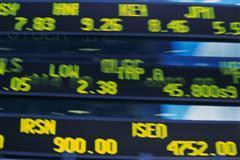| Home | About | Archives | RSS Feed |

@theMarket: Overhead Resistance Keeps Markets in Check
 "I don't get it," gripes an investor who called from Chicopee, "Congress goes and passes the tax-cut extensions, which is good news, right, and still the market does nothing. What gives?"
"I don't get it," gripes an investor who called from Chicopee, "Congress goes and passes the tax-cut extensions, which is good news, right, and still the market does nothing. What gives?"
By way of explanation, pundits argue that the passage of this event was already "baked in" to the averages, which is why the markets are trading close to the year's high. OK, I'll take that on board but there has been a lot of good news lately that should not have been discounted — higher consumer confidence, less unemployment, greater factory output — but the market appears uninterested. The much-heralded Christmas rally has stalled just below a key resistance area at 1,250 on the S&P 500 Index. So maybe we have hit the highs for this year already.
Last week, I wrote that it wouldn't surprise me if we saw a 50-75 point pullback in the S&P Index. I opinioned that the catalyst might be a congressional failure to pass the tax cut extensions. Although the extensions were passed, the markets still look like they would rather go down than up in the short term.
That is surprising since my friend in Chicopee is right. The latest government initiative could add somewhere between 0.50 percent to 1 percent to 2011 GDP. That is nothing to sneeze at so maybe fundamental analysis is not the place to look for an answer.
Technically most stocks, sectors and commodities are overextended. In order to correct that condition, the averages need to back and fill for a period of time or a market pullback is in order.
In addition, whenever markets approach a big technical area of resistance like 1,250, there is usually a battle of wills between the bulls and the bears. So why is 1,250 such an important number?
Readers may recall that by September 2008, Bear Sterns had already collapsed as had Fannie Mae and Freddie Mac, our two quasi-governmental mortgage giants. The House of Lehman Brothers was about to fall and that's when the S&P first broke 1,250 (on Sept. 3). It traded back and forth with a great deal of volatility around that level until Sept. 23 when it finally gave up the ghost and plummeted 48 points. Suffice it to say that the 1,250 level was not easily conceded by the bulls and what had once served as strong support for the markets, once broken, now also serves as an important resistance point in the index's attempt to move higher.
The process of testing that resistance level is what is occurring right now. My guess is that the bulls will ultimately win that struggle but not without a fight. I do not believe we will see the massive percentage point swings that we suffered through in 2008 but a milder, less dramatic give and take that could last for another week or so.
Whether the ongoing problems within the European financial sector will furnish the excuse the bears will need for a pullback remains to be seen. Higher interest rates over in the government bond market or a big move in the dollar could also spook investors. Regardless of the reason, I would be adding equity to my portfolio on any dip.
Bill Schmick is an independent investor with Berkshire Money Management. (See "About" for more information.) None of the information presented in any of these articles is intended to be and should not be construed as an endorsement of BMM or a solicitation to become a client of BMM. The reader should not assume that any strategies, or specific investments discussed are employed, bought, sold or held by BMM. Direct your inquiries to Bill at 1-888-232-6072 (toll free) or e-mail him at wschmick@fairpoint.net. Visit www.afewdollarsmore.com for more of Bill's insights.
| Tags: market, swings, bulls |

